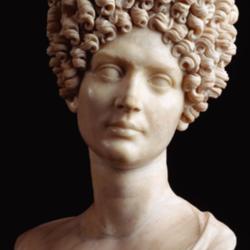Young Flavian Woman
Title
Young Flavian Woman
Date
Early 2nd Century AD, Flavian Dynasty
Artist or Workshop
Unknown
Materials
Marble
Height of the work
63 cm tall
Provenience
Rome, Italy
Current Location
The Capitoline Museum of Rome, Italy
Description and Significance
Description:
The Young Flavian Woman, also referred to as the Bust of Fonseca, depicts a female figure with her head tilted slightly to her left. The woman has a pointed nose and sharp features, such as her emphasized cheekbones. Her neck is quite long and lean and leads to her chest, which appears to be clothed in loose drapery. Her hair is upright in the front and consists of many small ringlets; these intricate ringlets fall on her forehead and in front of her ears. On the back of her head, the rest of her hair is pulled into a wide bun of braids. Small tendrils of hair frame the nape of her neck. The bust is in excellent condition and does not appear to have any significant damage.
Significance:
A delicate young female portrait is portrayed through the eyes of a detail-oriented sculptor in the Fonseca Bust. Her head tilts and her eyes look distant, as though she is deep in thought. She is characterized as a young Flavian woman as she is from the Flavian Dynasty, a time period in which Vespasian, Titus, and Domitian ruled over the Roman Empire. The Fonseca Bust’s hair probably the most defining characteristic of the bust. Described as a “circle of hair” (orbe comarum), the figure’s hair is quite unique and is representative of a distinctly Flavian style. The ringlets in front are pulled up quite high and frame her face, while a coiled, wide bun is situated on the back of her head. Chiaroscuro is created atop the head of the woman with the use of a manual drill, which the sculptor used to create depth within each ringlet. Some scholars believe that the hairstyle could have been an emulation (by many Flavian women such as this one) of the hairstyles worn by Domitia Longina, the wife of the Emporer Domitian. It is thought that a hairstyle this complex might have been kept in place with the help of beeswax or resin. Though many attribute this hairstyle to a wig or hairpiece, hairdresser and amateur archaeologist Janet Stephens, who specializes in ancient Roman hairstyles, believes that it was possible to achieve this through sewing the hair. Nevertheless, the hairstyle remains distinct to Flavian culture.
Though the bust is most often identified as Flavian, it is debated by some scholars that it is actually from the Trajanic Period. More specifically, the young woman is sometimes identified specifically as the niece of Trajan, Vibia Matidia.
The Young Flavian Woman, also referred to as the Bust of Fonseca, depicts a female figure with her head tilted slightly to her left. The woman has a pointed nose and sharp features, such as her emphasized cheekbones. Her neck is quite long and lean and leads to her chest, which appears to be clothed in loose drapery. Her hair is upright in the front and consists of many small ringlets; these intricate ringlets fall on her forehead and in front of her ears. On the back of her head, the rest of her hair is pulled into a wide bun of braids. Small tendrils of hair frame the nape of her neck. The bust is in excellent condition and does not appear to have any significant damage.
Significance:
A delicate young female portrait is portrayed through the eyes of a detail-oriented sculptor in the Fonseca Bust. Her head tilts and her eyes look distant, as though she is deep in thought. She is characterized as a young Flavian woman as she is from the Flavian Dynasty, a time period in which Vespasian, Titus, and Domitian ruled over the Roman Empire. The Fonseca Bust’s hair probably the most defining characteristic of the bust. Described as a “circle of hair” (orbe comarum), the figure’s hair is quite unique and is representative of a distinctly Flavian style. The ringlets in front are pulled up quite high and frame her face, while a coiled, wide bun is situated on the back of her head. Chiaroscuro is created atop the head of the woman with the use of a manual drill, which the sculptor used to create depth within each ringlet. Some scholars believe that the hairstyle could have been an emulation (by many Flavian women such as this one) of the hairstyles worn by Domitia Longina, the wife of the Emporer Domitian. It is thought that a hairstyle this complex might have been kept in place with the help of beeswax or resin. Though many attribute this hairstyle to a wig or hairpiece, hairdresser and amateur archaeologist Janet Stephens, who specializes in ancient Roman hairstyles, believes that it was possible to achieve this through sewing the hair. Nevertheless, the hairstyle remains distinct to Flavian culture.
Though the bust is most often identified as Flavian, it is debated by some scholars that it is actually from the Trajanic Period. More specifically, the young woman is sometimes identified specifically as the niece of Trajan, Vibia Matidia.
References
Musei Capitolini
Khan Academy
Bartman, Elizabeth. "Hair and the artifice of Roman female adornment." American journal of Archaeology (2001): pages 9-11.
Kleiner, Diana EE. Roman sculpture. Yale University Press, 1992. Page 149.
Stephens, Janet. "On (hair)pins and Needles" Ancient Roman Hairdressing (2013): pages 126 & 131
Khan Academy
Bartman, Elizabeth. "Hair and the artifice of Roman female adornment." American journal of Archaeology (2001): pages 9-11.
Kleiner, Diana EE. Roman sculpture. Yale University Press, 1992. Page 149.
Stephens, Janet. "On (hair)pins and Needles" Ancient Roman Hairdressing (2013): pages 126 & 131
Contributor
Charlotte Myers
Citation
Unknown, “Young Flavian Woman,” Digital Portrait "Basket" - ARTH488A "Ancient Mediterranean Portraiture", accessed June 7, 2025, http://classicalchopped.artinterp.org/omeka/items/show/43.
Item Relations
This item has no relations.

